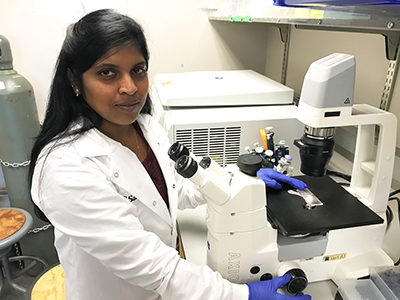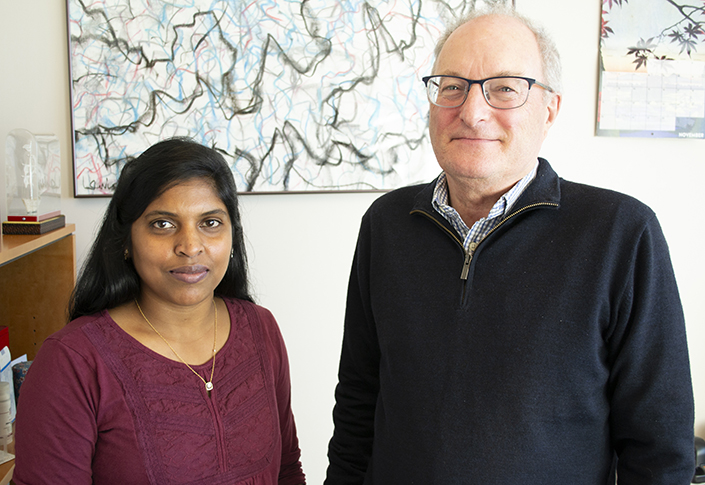Researchers Uncover Mechanisms behind Enigmatic Shapes of Nuclei
Scientists may be able to direct immune cells toward diseased areas
Story by:
Published Date
Article Content
Nearly 150 years ago, scientists discovered that specialized blood cells serve a vital role in immune system protection against infection and illness.
Certain groups of these white blood cells, now known as neutrophils, feature a nucleus that is structured strikingly different than most nuclei. The majority of cells feature round- or oval-shaped nuclei that are rigid, but neutrophils differ in that their nuclei adopt multiple lobular structures akin to that of flower petal arrangements.

Neutrophils, blood cells that serve as a first-response to invading bacteria, feature nuclei that — rather than being uniformly round as most other cells — are divided into multiple petals or lobes, allowing them to migrate into densely populated tissues. Here they are shown in human bone marrow (purple cells) in the company of many red blood cells. Credit: Dr. Huan-You Wang
These unique nuclear shapes permit neutrophils to travel all over the body to identify and combat invading pathogens. While much is now known about the role of neutrophils in combatting infection, how such peculiar nuclear structures are assembled has remained enigmatic since the 1880s. Reporting in Nature, University of California San Diego School of Biological Sciences Postdoctoral Scholar Indumathi Patta and Professor Cornelis Murre, in collaboration with Dr. Ming Hu at the Cleveland Clinic Foundation, have deciphered the shapeshifting puzzle of the neutrophil nucleus.

“We now know how these nuclear shapes are assembled and it’s a beautiful process,” said Murre, a distinguished professor in the Department of Molecular Biology.
Using a combination of ancient staining procedures combined with advanced techniques, named chromosome-conformation-capture studies, the researchers unveiled how flower-like nuclei are assembled. While chromosomes of rounded cells fold into stacked bundles of DNA loops, neutrophil genomes lack such loops. Remarkably, when the researchers removed chromatin loops, progenitor cells swiftly converted round nuclear shapes into flower petal arrangements like those found in neutrophils. This simple conversion also sufficed to activate thousands of genes associated with an inflammatory gene program that allows neutrophils to combat invading bacteria.
After unveiling the neutrophil loop assembly question, the researchers now believe they have the instructions to guide the development of new nuclear shapes.
“This potentially opens an exciting new chapter in immune therapeutics since theoretically it should be possible to change the nuclear structure of killer immune cells so that they can more easily invade complex, solid environments, such as tumors,” said Murre. “Essentially, this could lead to engineering novel nuclear shapes in effector immune cells, which is a new concept in therapeutics development.”
The authors of the study include: Indumathi Patta, Maryam Zand, Lindsay Lee, Shreya Mishra, Alexandra Bortnick, Hanbin Lu, Arpita Prusty, Sara McArdle, Zbigniew Mikulski, Huan-You Wang, Christine Cheng, Kathleen Fisch, Ming Hu and Cornelis Murre.
Funding for the research was provided by the National Institutes of Health, U.S.-Israel Binational Science Foundation and an Imaging Scientist Grant from the Chan Zuckerberg Initiative.

School of Biological Sciences Postdoctoral Scholar Indumathi Patta and Professor Cornelis Murre
Share This:
You May Also Like
Stay in the Know
Keep up with all the latest from UC San Diego. Subscribe to the newsletter today.



